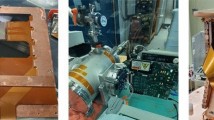Abstract
A theoretical and experimental investigation of the influence of eccentricity of the multiplication wire on the performance of cylindrical proportional counters is presented. The electric field in the counter is calculated by the method of images, and the Townsend formalism is used to derive the gas gain. The experimental determination of detector performance is carried out with37Ar. The dependence of the gas gain and of the counter resolution on eccentricity is discussed, and it is shown that eccentricities up to 0.2 are of no concern in microdosimetric measurements with cylindrical proportional counters.
Similar content being viewed by others
References
Rossi HH, Rosenzweig W (1955) A device for the measurement of dose as a function of specific ionization. Radiology 64:404–410
Rossi HH (1983) Multi-element dosimeters for radiation protection measurements. Health Phys 44:403–405
Rossi HH (1984) Development of microdosimetric counters, past, present and future. Radiat Prot Dosim 9:161–168
Boutruche B, Bordy JM, Barthe J, Segur P, Portal G (1994) A new concept of a high sensitivity tissue equivalent proportional counter for individual neutron dosimetry. Radiat Prot Dosim 52:335–338
Lindborg L (1976) Microdosimetry measurements in beams of high energy photons and electrons: Technique and results. In: Booz J, Ebert HG, Smith BGR (eds) Proceedings of the 5th Symposium on Microdosimetry. Commission of the European Communities, Luxembourg, pp 347–375
Menzel HG, Buhler G, Schumacher H (1982) Investigations of basic uncertainties in the experimental determination of micro-dosimetric data. In: Booz J, Ebert HG (eds) Proceedings of the 8th Symposium on Microdosimetry. Commission of the European Communities, Luxembourg, pp 1061–1072
Eickel R, Booz J (1976) The influence of the counter wall and counter shape on the spectral energy deposition in small volumes by60Co gamma-rays and 200 kV x-rays. Radiat Environ Biophys 13:145–165
Waker AJ, Maynard DG (1989) The effect of geometrical scaling on the gas gain of proportional counters intended for micro-dosimetric measurements. Radiat Prot Dosim 29:37–40
Anachkova E, Kellerer AM, Roos H (1994) Calibrating and testing tissue equivalent proportional counters with37Ar. Radiat Environ Biophys 33:353–364
Smythe WR (1950) Static and dynamic electricity. McGraw-Hill, New York, pp 75–78
Ségur P, Peres I, Boeuf JP, Bordage MC (1989) Microscopic cal-culation of the gas gain in cylindrical proportional counters. Radiat Prot Dosim 29:23–30
Chen J (1991) Mikrodosimetrie in variierenden Strahlenfeldern. Entwicklung der Varianz-Kovarianz Methode. Dissertation, University of Würzburg, Germany
Author information
Authors and Affiliations
Rights and permissions
About this article
Cite this article
Anachkova, E., Roos, H., Nekolla, E. et al. Effect of wire eccentricity on the performance of cylindrical proportional counters. Radiat Environ Biophys 34, 245–249 (1995). https://doi.org/10.1007/BF01209750
Received:
Accepted:
Issue Date:
DOI: https://doi.org/10.1007/BF01209750




